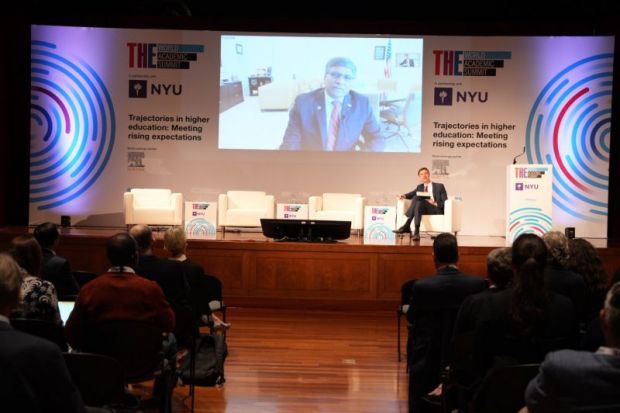The Biden administration is expanding its push to help less-competitive institutions share in federal research funding, opening an office to help guide their students and scientists through its grant application processes.
The office opening this month within the National Science Foundation is meant to recognise the vast amounts of talent outside the nation’s elite research universities, the NSF’s director, Sethuraman Panchanathan, told Times Higher Education’s World Academic Summit.
“They have great ideas and talent,” Dr Panchanathan said of students and faculty at a broad assortment of institutions that typically win little or no NSF money, including minority-serving institutions, primarily undergraduate institutions and community colleges.
“You want them to succeed; you want those institutions to succeed,” he told the summit, held at New York University.
The new NSF initiative is called Granted – Growing Research Access for Nationally Transformative Equity and Diversity. Its services – delivered around the country through online formats – will help teach academic staff and students at the targeted institutions how to develop their ideas for research projects, prepare their grant applications, assemble scientific teams and cultivate partnerships. It also aims to help their institutions start offering many of those same services.
The widespread lack of such capabilities, the NSF says in outlining the effort, “puts talented [principal investigators] at these institutions at a disadvantage and prevents the nation from benefiting from numerous impactful scientific advances and the advancement of STEM talent”.
That mirrors a growing sense among policymakers in both political parties that the US system of academic science – while world-leading thanks to its emphasis on merit-based competition for tens of billions of dollars a year in federal investment – may be overlooking important stores of talent outside what Dr Panchanathan called “the usual suspect institutions”.
One of the biggest, most enduring and most controversial tools in that direction is Epscor, a four-decade-old set-aside of federal research dollars for institutions in states that fare poorly in the regular peer-review-based assessment of research grant applications. Epscor has been redirecting about 12.5 per cent of NSF grant funding to such states, and Congress this year voted to increase that level to 20 per cent by 2025, despite analyses showing that Epscor generally has not succeeded in boosting the ability of beneficiary institutions to join the realm of competitive universities.
Dr Panchanathan told the THE summit that he had been motivated to pursue the Granted programme after visiting students and instructors at such places as Johnson County Community College in Kansas. “I found them as excited, if not more, to be part of research discovery,” the NSF director said.
Register to continue
Why register?
- Registration is free and only takes a moment
- Once registered, you can read 3 articles a month
- Sign up for our newsletter
Subscribe
Or subscribe for unlimited access to:
- Unlimited access to news, views, insights & reviews
- Digital editions
- Digital access to THE’s university and college rankings analysis
Already registered or a current subscriber? Login








